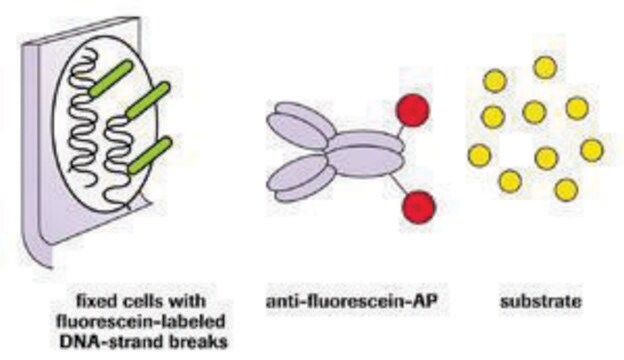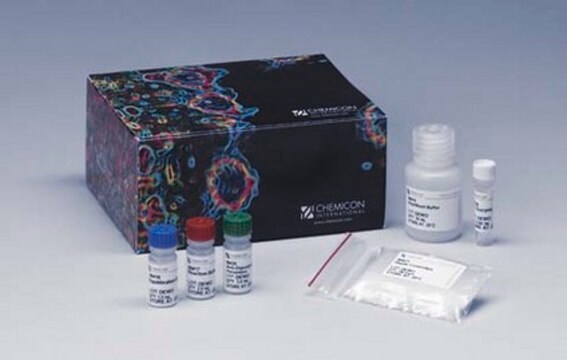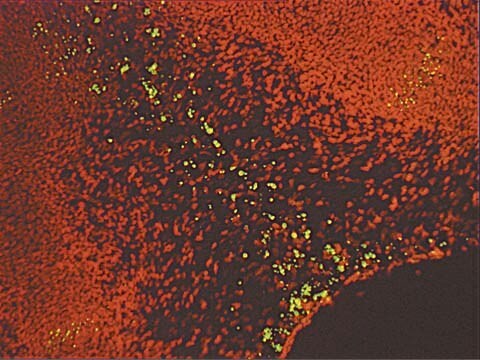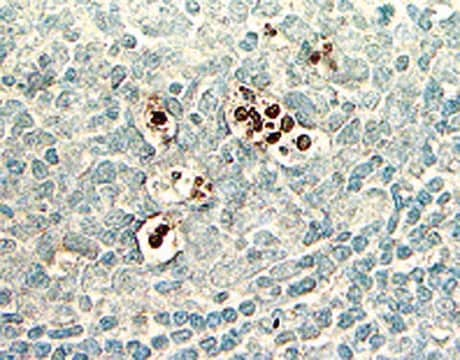12156792910
Roche
Zestaw do wykrywania śmierci komórek in situ, czerwony TMR
sufficient for ≤50 tests
Synonim(y):
red, tm, zestaw do wykrywania śmierci komórek in situ, tm red, zestaw do wykrywania śmierci komórek in situ
About This Item
Polecane produkty
zastosowanie
sufficient for ≤50 tests
Poziom jakości
producent / nazwa handlowa
Roche
metody
flow cytometry: suitable
temp. przechowywania
−20°C
Powiązane kategorie
Opis ogólny
The hallmark of apoptosis is DNA degradation, which in early stages, is selective to the internucleosomal DNA linker regions. The DNA cleavage may yield double-stranded and single-stranded DNA breaks (nicks). Both types of breaks can be detected by labeling the free 3′-OH termini with modified nucleotides (e.g., biotin-dUTP, DIG-dUTP, fluorescein-dUTP) in an enzymatic reaction. The enzyme terminal deoxynucleotidyl transferase (TdT) catalyzes the template-independent polymerization of deoxyribonucleotides to the 3′-end of single- and double-stranded DNA. This method has also been termed TUNEL (TdT-mediated dUTP-X nick end labeling). Alternatively, free 3′-OH groups may be labeled using DNA polymerases by the template-dependent mechanism called nick translation. However, the TUNEL method is considered to be more sensitive and faster.
Sample material: Cells in suspension, cytospin and cell smear preparations, adherent cells grown on slides, and frozen and paraffin-embedded tissue sections.
Principle
The In Situ Cell Death Detection Kit, TMR red is based on the detection of single- and double-stranded DNA breaks that occur at the early stages of apoptosis.
Apoptotic cells are fixed and permeabilized. Subsequently, the cells are incubated with the TUNEL reaction mixture that contains TdT and TMR-dUTP. During this incubation period, TdT catalyzes the addition of TMR-dUTP at free 3′-OH groups in single- and double-stranded DNA. After washing, the label incorporated at the damaged sites of the DNA is visualized by flow cytometry and/or fluorescence microscopy.
Specyficzność
Zastosowanie
Opakowanie
Uwaga dotycząca przygotowania
The optimal enzyme concentration range from 0.5 to 5 U per assay. For a standard 50 μl PCR, we recommend using 2 U of the enzyme blend.
Working solution: Add total volume (50 μl) of Enzyme Solution to the remaining 450 μl Label Solution to obtain 500 μl TUNEL reaction mixture.
Mix well to equilibrate components.
Storage conditions (working solution): The TUNEL reaction mixture should be prepared immediately before use and should not be stored. Keep TUNEL reaction mixture on ice until use.
Tylko elementy zestawu
- Enzyme Solution (TdT)
- Label Solution (TMR-dUTP)
Hasło ostrzegawcze
Danger
Zwroty wskazujące rodzaj zagrożenia
Zwroty wskazujące środki ostrożności
Klasyfikacja zagrożeń
Aquatic Chronic 2 - Carc. 1B Inhalation
Kod klasy składowania
6.1D - Non-combustible acute toxic Cat.3 / toxic hazardous materials or hazardous materials causing chronic effects
Klasa zagrożenia wodnego (WGK)
WGK 3
Temperatura zapłonu (°F)
does not flash
Temperatura zapłonu (°C)
does not flash
Wybierz jedną z najnowszych wersji:
Masz już ten produkt?
Dokumenty związane z niedawno zakupionymi produktami zostały zamieszczone w Bibliotece dokumentów.
Klienci oglądali również te produkty
Produkty
Cellular apoptosis assays to detect programmed cell death using Annexin V, Caspase and TUNEL DNA fragmentation assays.
Testy apoptozy komórkowej do wykrywania zaprogramowanej śmierci komórki przy użyciu aneksyny V, kaspazy i testów fragmentacji DNA TUNEL.
Powiązane treści
Zestaw do wykrywania śmierci komórek in situ TMR czerwony protokół
Nasz zespół naukowców ma doświadczenie we wszystkich obszarach badań, w tym w naukach przyrodniczych, materiałoznawstwie, syntezie chemicznej, chromatografii, analityce i wielu innych dziedzinach.
Skontaktuj się z zespołem ds. pomocy technicznej









